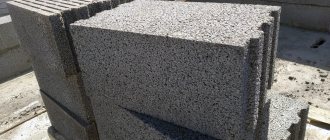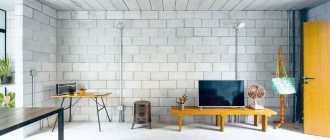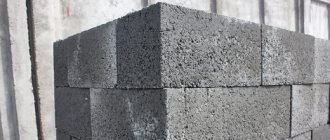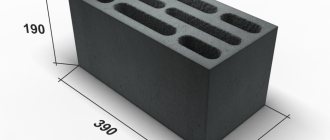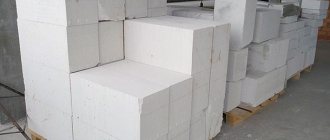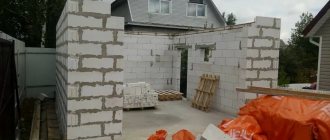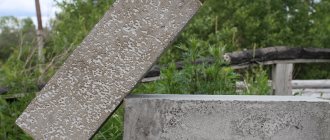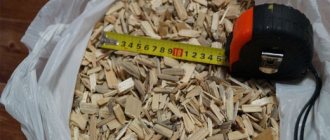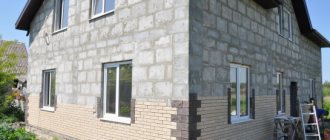They have good geometry, low weight, which is why special lifting equipment is not required for their installation.
Expanded clay blocks adhere perfectly to any finishing material. To start building a house from this raw material, you need to familiarize yourself with all its features.
Production technology and composition
The following raw materials are used for manufacturing: cement, expanded clay, water; the presence of fillers and plasticizing additives is allowed. For preparation, the following proportion of components is usually used - 8/3/1 for expanded clay, sand and cement.
It’s worth clarifying right away that the recipe is not a reference. By changing the ratio of components, the manufacturer can improve the characteristics of the finished product. For example, adding cement will increase strength, but will negatively affect thermal insulation. Adding expanded clay will increase the insulating properties, but will affect the strength of the block.
Water is added “to taste”, depending on the moisture content of the raw materials. Ideally, the finished solution should resemble thick sour cream in consistency. To do this, 2-3 minutes of mixing the components in a concrete mixer is enough.
Then the blocks are formed and the mixture is vibrated. At the final stage, the products are dried in molds for at least 2 days. After this, the blocks are removed from the molding containers and dried in the open air for about 8-10 days.
Making modules yourself
To find an excellent building material for your own home, you should not despair if the blocks in the region are of poor quality - make your own expanded clay modules. Despite the fact that it is much cheaper, despite the need to purchase special equipment, it is possible to vary the thermal conductivity depending on the required amount of material of a particular energy efficiency. Among other things, make modules of the required length, wall thickness and other dimensions. Experiments are permissible, but within small limits and only for the construction of non-format objects for economic or domestic purposes: fences, toilets, partitions.
In all other cases, it is better to adhere to this recipe and strictly observe the components of the working mixture. We bring to your attention several composition options:
- For wall stones with a concrete yield of grade M150 of approximately 1430/1590 kg/m3, 1 m3 will require:
- Portland cement M400 - 230 kg;
- Expanded clay gravel, fraction 5-10 mm, density 800 kg/m3 750 kg;
- Pure quartz sand 2-2.5 mm – 600 kg;
- Water – 190 l.
- To make modules resistant to water, aggressive environments and freezing, you can make a composition from:
- 250 kg of cement;
- 460 kg of expanded clay mixture;
- 277 kg of expanded clay sand;
- Water at the rate of 9 parts to 1 part cement;
- Bitumen emulsion in the amount of 10% of the total volume of water.
- To get hollow modules, you need to take:
- 55 kg of expanded clay;
- 27.2 kg of pure quartz sand;
- 9.21 kg of cement;
- 9.09 liters of water.
From the amount of the finished mixture, 10 hollow blocks are obtained.
Advice! If you don’t have a dispenser at hand, take a bucket per unit volume. Then the components of the mixture will look like this: cement M400 - 1 bucket, clean sand 5mm - 2 buckets, expanded clay with a density of 350-500 kg/m3 - 8 buckets, water 1.5 buckets. But there may be more or less water, depending on what mixture is needed to obtain proper thermal conductivity.
If you prepare the batch carefully, follow the parameters of the components, dry the modules completely, you will get ideal expanded clay concrete blocks, as in the photo from the factory manufacturers. And the house will be built much faster, cheaper, and most importantly, the developer will be completely confident in the quality of the material.
Source: kakpostroitdomic.ru
Specifications
Mechanical characteristics are specified in GOST 6133-99 , 10180-90 and 12730.1-78 .
The energy saving options are as follows:
The key parameter of any masonry material is thermal conductivity, which in our case depends linearly on the density of the building block.
| Density, kg/m3 | Thermal conductivity coefficient, W/(mS) |
| 1800 | 0,81–0,90 |
| 1600 | 0,66–0,78 |
| 1400 | 0,57–0,64 |
| 1200 | 0,45–0,53 |
| 1000 | 0,32–0,42 |
| 800 | 0,25–0,32 |
| 600 | 0,21–0,27 |
| 500 | 0,18–0,24 |
The vapor permeability of the material is comparable to wood and drywall. Aerated concrete “breathes” 2 times better than brick.
| Density, kg/m3 | Vapor permeability, mg/(m h Pa) |
| 1400 | 0,094 |
| 1200 | 0,108 |
| 1000 | 0,138 |
| 800 | 0,187 |
| 600 | 0,256 |
Our production
Block KSR-PR-PS expanded clay concrete
- Dimensions according to GOST (mm) – 390x190x188
- Weight 1 pc. – 13 kg
- Quantity per 1 m3 – 72 pcs.
- Strength grade – M-35
- Frost resistance – F50
- On a pallet – 90/105 pcs.
- Max quantity in the car – 1680 pcs.
KSR-PR expanded clay concrete block
- Dimensions according to GOST (mm) – 390x190x188
- Weight 1 pc. – 19 kg
- Quantity per 1 m3 – 72 pcs.
- Strength grade – M-75
- Frost resistance – F50
- On a pallet – 90 pcs.
- Max quantity in the car – 1260 pcs.
KSR-PR expanded clay concrete block
- Dimensions according to GOST (mm) – 390x290x188
- Weight 1 pc. – 27 kg
- Quantity in 1 m3 – 45 pcs.
- Strength grade – M-50
- Frost resistance – F50
- On a pallet – 60 pcs.
- Max quantity in the car – 840 pcs.
Block KPR-PR(PS) expanded clay concrete
- Dimensions according to GOST (mm) – 390x90x188
- Weight 1 pc. – 5.5/9 kg
- Quantity per 1 m3 – 150 pcs.
- Strength grade – M-35
- Frost resistance – F50
- On a pallet – 180 pcs.
- Max quantity in the car – 3600 pcs.
Block KSR-PR-PS6 expanded clay concrete
- Dimensions according to GOST (mm) – 390x290x188
- Weight 1 pc. – 19 kg
- Quantity in 1 m3 – 45 pcs.
- Strength grade – M-35
- Frost resistance – F50
- On a pallet – 60 pcs.
- Max quantity in the car – 1200 pcs.
FBS sand-cement block
- Dimensions according to GOST (mm) – 390x190x188
- Weight 1 pc. – 31 kg
- Weight 1 m3 – 2232 kg
- Strength grade – M-200
- Frost resistance – F50
- On a pallet – 70 pcs.
- Max quantity in the car – 660 pcs.
Classification
Expanded clay blocks are divided according to structure:
- Hollow . They are characterized by relatively low weight, have high rates of sound insulation and thermal conductivity.
- Full-bodied . They differ from previous products in their high resistance to dynamic loads. Such blocks can be used for the construction of load-bearing walls or foundations of low-rise buildings.
1 - solid wall block, 2 - 4-slot wall block, 3 - 7-slot wall block, 4 - double-hollow wall block, 5 - partition 2-hollow block.
Blocks are also divided according to purpose. In particular:
- Wall . From the name it is clear that the product is intended for the construction of supporting wall structures.
- Septal . They have less strength and are therefore intended for interior partitions and the construction of non-load-bearing walls.
- Ventilation . Such blocks are provided with technical grooves that simplify the installation of utilities.
It is important to understand that depending on the labeling and purpose, the performance properties of the finished product also change.
Varieties
To produce stones from expanded clay concrete, three main components are used: expanded clay, cement and sand. Depending on the place of use, blocks can be:
- wall – width from 150 mm;
- partition – up to 150 mm.
Also, depending on the purpose, wall walls are divided into:
- front - for laying external walls (without finishing);
- ordinary - for internal walls (with subsequent finishing);
- corner;
- dressings.
The front ones, also depending on the place of application, are produced with one (side) or two (side and end) front sides. The front surface can be smooth or grooved, painted with pigments or colored cement.
Video: Testing of expanded clay concrete blocks "ASTEK" in the laboratory of the Polytechnic University.
At the end, the blocks can be flat or with grooves, as well as tongue and groove. Corners are made straight or rounded. The surface can be flat or with longitudinal grooves, which are located at a distance of 20 mm from the side surface.
In addition, expanded clay concrete stones are produced solid and hollow. In hollow blocks, the voids are made non-through and through. The number of evenly distributed voids is up to 10.
Hollow products are characterized by lower thermal conductivity, good sound insulation, and due to the fact that they require less material, their cost is lower. However, voids reduce the strength of the product.
Advantages and disadvantages
To better understand the characteristics of a material, you can classify its strengths and weaknesses into separate categories. Let's start with the positive points.
Advantages:
- Low production costs, which has a positive effect on the price of finished products.
- The use of natural materials guarantees environmental safety.
- Long service life.
- Almost complete absence of shrinkage.
- Specific low weight of blocks.
- High strength.
- Resistance to any temperature influences.
Flaws:
- Difficulty in processing.
- Lack of ideal geometry.
- Relatively low thermal insulation rates.
- Mandatory surface finishing.
In addition, in multi-storey buildings only blocks with a high cement content can be used, which leads to increased costs.
Advantages and disadvantages
The light weight and low strength of expanded clay blocks allows them to be used for the construction of houses with an unreinforced foundation. The construction speed is 4-5 times higher, which means you can move into your new home faster. The material maintains heat and humidity in the room. Expanded clay resists the formation of mold and mildew, pests and rodents. A wide selection of block sizes and shapes will allow you to create walls with the desired parameters.
The disadvantage of expanded clay blocks is their low resistance to impact loads. The material is difficult to saw; when cut, the edges crack and are not even.
Positive sides:
- low price;
- fast construction;
- strength and durability;
- low weight;
- excellent sound insulation;
- low thermal conductivity;
- cost-effectiveness of masonry work;
- fire resistance and absence of toxic combustion products;
- Possibility of finishing: decorative plaster and tiles.
Standard sizes according to GOST
Expanded clay blocks are manufactured in accordance with GOST, however, this does not imply the use of identical standard sizes. Depending on the structure and purpose, the following material sizes are found on the market:
- Wall. Length – 190-390 mm, width – 138-288 mm, height – 138-188 mm.
- Septal. Length – 190-590 mm, width – 90-120 mm, height – 188 mm.
- Ventilation. The size used here is 390*190*188 mm.
Note that such standard sizes are regulated by GOST number 6133 as amended in 1999 . Some nuances and errors are acceptable here, so the product sizes given are recommended rather than reference.
| Block type | Length(Lmm) | Width (bmm) | Height (hmm) | Number of blocks in a pallet |
| Wall | 288 | 288 | 138 | 75, 90, 180 |
| 288 | 138 | 138 | 75, 90, 180 | |
| 390 | 190 | 138 | 75, 90, 180 | |
| 290 (288) | 190 | 138 | 75, 90, 180 | |
| 190 | 190 | 138 | 75, 90, 180 | |
| 90 | 190 | 138 | 75, 90, 180 | |
| Septal | 590 | 90 | 188 | 180 |
| 390 | 90 | 188 | 312 | |
| 190 | 90 | 188 | 500 |
With decorative coating
Options
Recommended block sizes are specified in GOST 28984. The most popular are blocks whose size is (length, width and height, in cm): 39 x 24 x 18.8; 40 x 40 x 20; 39 x 39 x 18.8.
Deviation from the standards in the manufacture of blocks is allowed no more than:
| Parameter name | indicators | |
| Standard (ordinary) block | façade | |
| Length and width, in mm | ±3 | ±3 |
| Width, mm | ±4 | ±3 |
| Wall thickness in hollow blocks, mm | 3 | 2 |
| Maximum pothole depth, mm | 4 | 4 |
| Depth of depression and height of build-up | 2 | 2 |
| Chip depth on block edge, mm | 5 | 5 |
You can find out more about other deviations by studying GOST 33126-2014.
Weight of expanded clay concrete blocks
The operational weight of expanded clay concrete blocks is also diverse. Given that the finished product involves the presence or absence of voids, the material cannot weigh the same. Therefore, we will consider the standard mass of blocks depending on their structure.
- Products that have from 4 to 8 hollow cells: 11-14 kg .
- Blocks with ten hollow cells: 13-16 kg .
- Products with two voids: 14 kg .
- Solid block (wall): 17 kg .
- Partition blocks (hollow/solid): 6/8 kg .
The weight of ventilation units is usually 11 kg .
Speaking about operating weight, we can consider two more issues that will be useful to private developers. They sound like this:
How many expanded clay concrete blocks are there in 1 m3?
Here you can turn to mathematics and multiply the sides of a standard block, dividing the result by the unit of measurement. Using this formula, it turns out that 1 m3 of masonry corresponds to 71.78 wall blocks.
Given the disproportionate geometry, the resulting number is usually rounded, which gives 72 blocks per 1m3 . It is worth noting that taking into account the mortar joint, the actual amount of material will be noticeably lower. Partition blocks usually require more, so their number per 1 m3 varies between 112-139 pieces, depending on the size.
How many blocks are in a pallet?
There is no clear answer to this question. Manufacturers are not subject to strict packaging requirements, so suppliers focus on two fundamental factors: the size of the pallet and the weight of expanded clay concrete blocks. Therefore, the following indicators are found on the market: 72, 84, 90 and 105 pieces per pallet.
Note that this configuration is typical for wall blocks. Partition analogues are smaller in width, so they can be stacked in quantities of 120-160 pieces.
Knowing these nuances, you can not only accurately calculate the required number of blocks, but also calculate the load on the load-bearing supports.
Types of expanded clay blocks
Expanded clay blocks are divided according to the following characteristics:
- by weight and size;
- by the presence, quantity and type of voids;
- according to the quality level of the surface of the side faces.
The following standards are provided for the manufacture of blocks:
- 190x280x390 mm – blocks for the construction of walls (wall blocks);
- 190x190x390 mm – blocks for creating partitions (partition blocks).
The use of blocks allows you to quickly build walls and partitions in a house or apartment. A house made of expanded clay concrete blocks is built 4-5 times faster than one made of brick. The cost of concrete solution is reduced by 2 times. The total weight of the wall is reduced by 1.5 times, which reduces the load on the foundation.
A wall block made of expanded clay weighs from 14 to 26 kg. Partition blocks weigh from 8-23 kg.
Blocks are divided into 2 groups according to the quality of the surface of the side faces:
- Ordinary - used for the construction of walls with subsequent finishing.
- Facial – the expanded clay block has a decorative coating on one of its surfaces.
Based on the presence and location of voids, expanded clay concrete blocks are divided into:
- Solid - durable blocks without voids for high loads.
- Hollow (slotted) - inside the blocks there are voids and holes - through or sealed.
Solid blocks are used to create strong walls that bear heavy loads. Hollow blocks retain heat better and are used in cold climates. The presence of voids allows you to reduce noise, reduce product weight and product cost. Due to their weak strength, hollow blocks are recommended for the construction of 1, 2 or 3 storey houses, cottages, and garages.
Material life
Expanded clay concrete blocks belong to the category of durable materials. Manufacturers claim that the service life of their products varies between 50-100 years. It should be clarified that there is no exact data on the service life of expanded clay concrete blocks. Therefore, the manufacturer's data can be questioned.
However, according to the results of laboratory tests, wall blocks are designed for 50 freezing cycles. For most regions of Russia, one such cycle is equal to a calendar year, so we can assume that 50 years is the guaranteed service life of an expanded clay concrete block.
What is concrete-expanded clay stone?
Expanded clay concrete is a type of building material, the main components of which are :
- cement;
- sand;
- water;
- expanded clay and various additives.
Expanded clay is baked clay. When making expanded clay concrete, expanded clay granules with a size of 5 mm or more are certainly used.
This material has a low density, which allows the walls to “breathe”. It is also called a bioblock.
What does it look like in the photo?
The peculiarity of expanded clay concrete is that the structure of this building material contains expanded clay granules, the space between which is filled with a mixture of cement and quartz sand.
This material cannot be confused with any other concrete-containing material, since if you cut it, inside, between the cement-sand mortar, you can see lumps of expanded clay.
The photo shows expanded clay concrete blocks:
Which is better: expanded clay concrete or aerated concrete?
Both of these materials belong to the class of cellular concrete, and therefore are widely used in modern construction. To find out which is better, it is necessary to conduct a comparative analysis of the main characteristics. This is what we end up with:
- Durability . Expanded clay concrete blocks use expanded clay as a filler, while aerated concrete analogues use air. Accordingly, the first option is preferable.
- Practicality . Aerated concrete blocks are prone to crumbling and cracking over time. This is not typical for expanded clay concrete. In addition, you can easily hammer a nail into aerated concrete, but it will not stay in the block. Therefore, difficulties may arise during interior decoration.
- Dimensions and weight . Both options have minimal weight, however, aerated concrete blocks have large dimensions, so walls can be built from them faster.
- Thermal insulation . Here the winner is aerated concrete, which, thanks to its air chambers, prevents heat loss indoors.
It is worth noting that aerated concrete is not suitable for arranging foundations and is rarely used in multi-storey buildings. If we consider the financial side, expanded clay concrete is more profitable. It is enough to cite one fact: the construction of walls made of aerated concrete implies the mandatory presence of a reinforcing belt; for expanded clay concrete this is an optional condition.
| physical characteristics | Expanded clay blocks | Foam blocks | Gas silicate blocks |
| Strength (kg/cm2) | 25-150 | 10-60 | 10-40 |
| Thermal conductivity (W/mdegree) | 0,15-0,45 | 0,10-0,40 | 0,10-0,30 |
| Density (kg/m3) | 500-1800 | 450-900 | 200-900 |
| Frost resistance (number of cycles) | 15-50 | 15-50 | 15-35 |
| Water absorption (in%) | 50 | 85 | 95 |
Reviews about expanded clay blocks
“First of all, I would like to note the low cost of construction and the ease of working with expanded clay concrete.
He built everything himself - both the house and the bathhouse. No hired craftsmen or professional assistants. A “cube” of expanded clay block masonry cost me about 2,300 rubles. The sound insulation is excellent, and heat conservation is very good. If you carefully read the nuances of choosing a stone and buy what suits you, then no problems will arise. I believe that all the reviews I come across about the pros and cons of blocks are somewhat subjective, and the latter are caused by non-compliance with the technology and lack of experience working with them.” Vladimir Gorshkov, Moscow.
“My review of expanded clay concrete is the best. For an individual developer, the low thermal conductivity of the material and high-quality sound insulation of the house are attractive. And taking into account the fact that the dimensions of expanded clay concrete blocks are identical (if it is not “self-made”), then there is no need to hire specialists. I built it myself, I know what I’m talking about. The main thing is to buy a stone with the required characteristics, then there will be no problems.”
Andrey, Omsk.
“Before building a bathhouse on the site, I spent a lot of time to clarify what the characteristics of expanded clay concrete stones are. After all, its operation is associated with a number of features - temperature changes, dampness. Plus to this is the need for more reliable insulation. I asked the opinions of knowledgeable people, read reviews on thematic forums. Surprisingly, no one noted the disadvantages of a bathhouse made of expanded clay blocks. And now, 2 years after the completion of construction, I can say unequivocally - I agree with everything I heard earlier. I did the right thing by choosing this product.”
Marat Rudenko, Ufa.
“There are no ideal materials. When purchasing expanded clay blocks, you should decide which characteristics should be a priority. This approach will eliminate the need to evaluate the fairness of judgments about the pros and cons of the material. It is clear that each of us has our own criteria. In general, expanded clay concrete is an excellent stone. We’re just not used to building from it yet, which is why a lot of questions arise.”
Oleg, Rostov.
Pros and cons of expanded clay concrete blocks
Advantages:
1. Easy to transport and install. This is primarily due to its low weight and significant size. Consequently, the price of building a house is reduced, and not least because of savings on the foundation.
2. Convenience of finishing. Expanded clay concrete base goes well with almost all types of finishing (cladding) materials.
3. Low thermal conductivity. One of the significant advantages of expanded clay concrete blocks allows you to save on building insulation. That is why it is good to build residential buildings and bathhouses from them, for which the ability of the material to retain heat is an important factor.
4. Density sufficient to avoid problems with attaching anything attached, as when arranging structures made of foam concrete.
5. Good sound insulation. According to reviews from the owners, it can be further improved if you buy an expanded clay concrete hollow block.
6. Strict sample sizes. This facilitates further finishing of expanded clay block surfaces.
Flaws:
If we evaluate expanded clay blocks from the point of view of their disadvantages, then sometimes there are diametrically opposed opinions about this artificial stone. But if you analyze them all, then, judging by the reviews of those who built their own, there are only two main shortcomings.
- Fragility of blocks. This complicates the process of cutting them somewhat. The edges are uneven, which makes it difficult to fit the products in place. How significant this minus is is another question, since it is unknown what tool was used when cutting expanded clay blocks and the skill level of the master.
- Instability under shock loads. And on this point, it is advisable to clarify what type of expanded clay concrete sample we are talking about. Whether it is hollow or solid, the density of the block declared by the manufacturer.
Conclusion
- If we summarize all the reviews about the products, it turns out that taking into account the characteristics of expanded clay blocks and their price, such construction for the private sector is one of the most attractive options. Moreover, there are still much more advantages than disadvantages, and they are much more significant.
- All of the above is true only if we are talking about certified products. In numerous expert reviews about expanded clay blocks, the emphasis is on this. You should look at the documentation before purchasing. In addition, the low cost of expanded clay blocks is a reason to doubt the feasibility of the purchase. It is unlikely that their characteristics will correspond to those stated.
List of reliable manufacturers
When choosing a building material, the main attention is paid to its quality, on which the service life of the building will directly depend. Therefore, when purchasing expanded clay concrete, you can pay attention to the products of the following manufacturers:
- LLC "Yakovlevostroydetal " This is one of the largest domestic manufacturers, known as the Belgorod ZhBK-3 plant. The company has been operating for more than 50 years and was renamed in 2005 . The company strictly follows GOST standards, producing over 600 types of products.
- JSC "BCSM " This abbreviation hides the Beskudnikovsky Construction Materials Plant. The company was founded in 1926 , however, it began to specialize in the production of expanded clay concrete blocks in the 80s of the last century, after reconstruction. All manufactured products are subject to mandatory certification; there are conclusions from the SES on environmental safety.
- "Klinstroydetal" . This is the most famous manufacturer of bricks and tiles in Russia. It is worth noting that the company was one of the first in the central region of the country to launch a line for the production of expanded clay concrete blocks. High demands are placed on finished products; the technological process is controlled at all stages.
In addition, the products of JSC Keramzit, Serpukhov, and LLC Podmoskovye, located in Kolomna, deserve high marks from specialists.
Expanded clay concrete blocks GOST: overview of the main characteristics and requirements of technical documentation
Expanded clay concrete is a fairly popular material, due to its special set of properties and qualities. And, for sure, many future home owners at least potentially considered products made from it as a material suitable for building their own home.
Like any other building material, it is subject to certain technical documentation requirements. It is their content that we will consider in this article. Expanded clay concrete blocks GOST: what does the quality standard say?
Scope of application
Expanded clay concrete material is popular among modern builders. They build from it :
- multi-storey buildings;
- cottages, private houses;
- garages;
- outbuildings.
Load-bearing walls of not only civil buildings, but also industrial ones are made from expanded clay concrete sections.
During the construction of monolithic buildings, inter-apartment and interior partitions are often made of expanded clay stones . They have precise dimensions and can be combined with a variety of building materials and metal structures.
Reception of products, storage and transportation
In addition to technical and physical properties, the standard contains comprehensive information about the rules for product acceptance, which we will now consider.
Acceptance rules
Instructions for accepting products are as follows:
- Products are accepted by the manufacturer's control body;
- Acceptance is carried out based on the results of acceptance and periodic tests of product compliance with standards;
- The maximum batch is considered to be 250 m3. A batch is defined as a set of products manufactured in one shift, from the same raw materials and with similar properties and qualities;
- Acceptance tests include: control of compressive strength, tempering strength, geometric deviations of products, and other external characteristics.
- The following are subjected to periodic testing: frost resistance, thermal conductivity, density, sound insulation.
Each batch of products must be accompanied by a document of conformity (quality), which contains the following information:
- Batch number, date of manufacture and date of issue of the document;
- Standard number;
- Number of products;
- Material acceptance date;
- Compressive strength;
- Frost resistance of blocks;
- Density grade;
- Manufacturer's name and address;
- Symbol of products.
Requirements for transportation and storage rules for products
Transportation of products can be carried out by any type of transport. During transportation, the requirements for securing the material and packaging must be met. Unloading and loading operations are prohibited by dumping.
Storage is carried out mainly on standard pallets. Products must be protected from environmental influences by insulating them with film. Storage can be carried out both indoors and outdoors.
Storage of expanded clay blocks, photo
